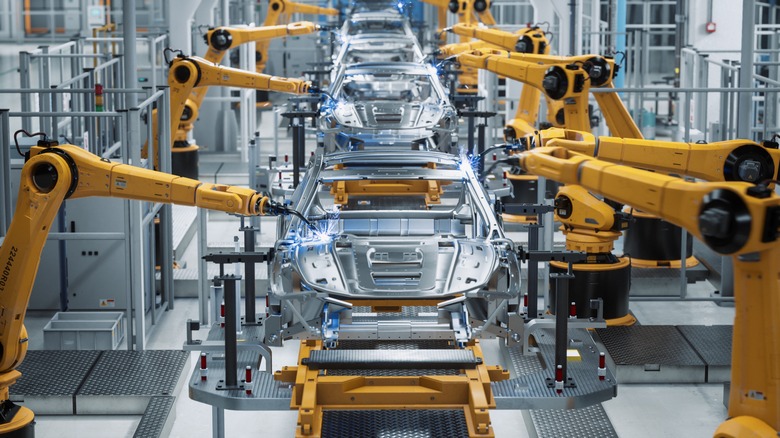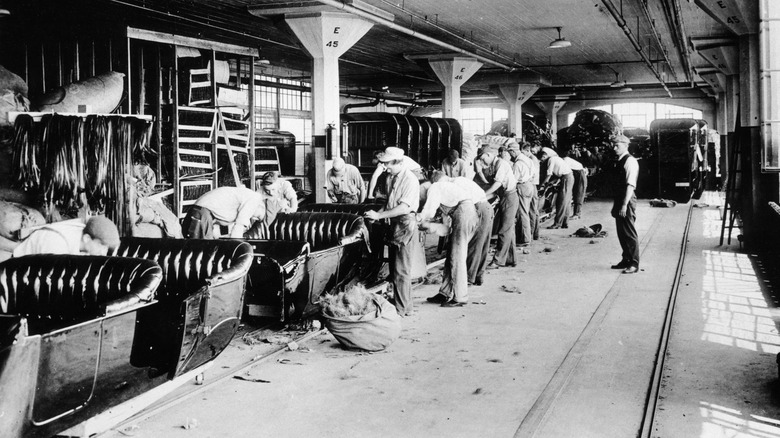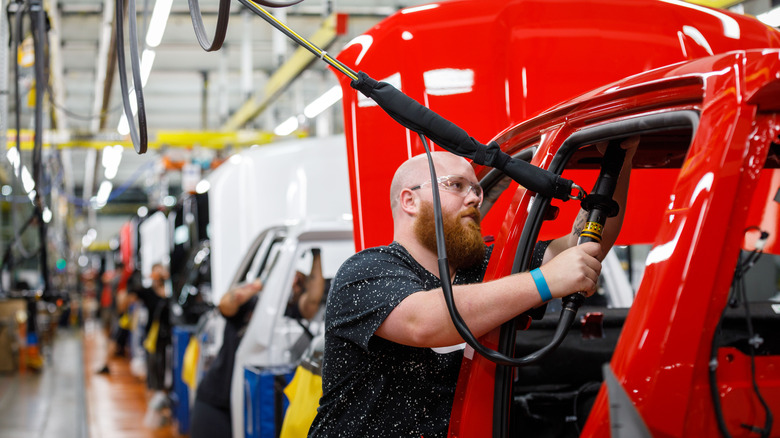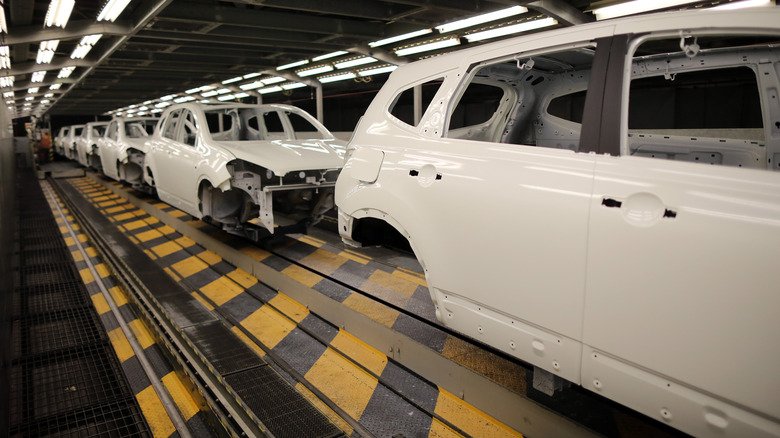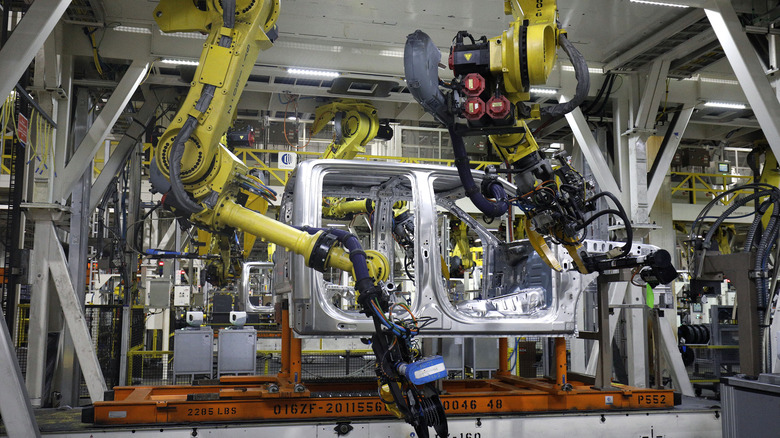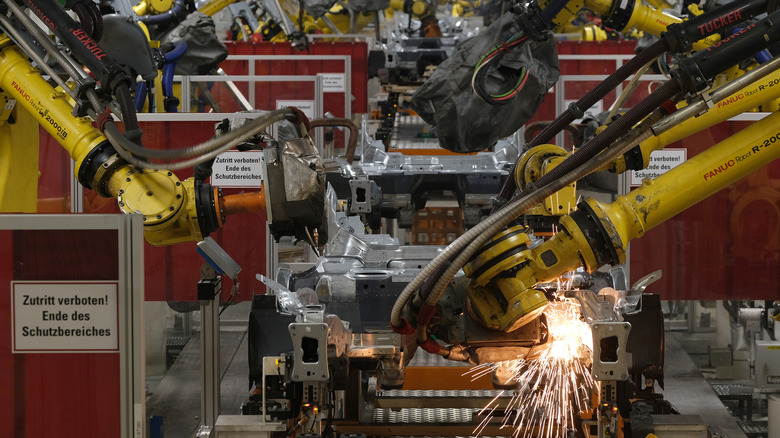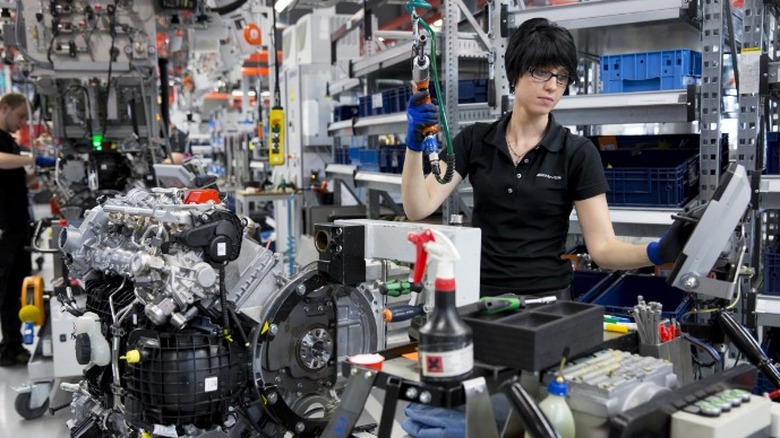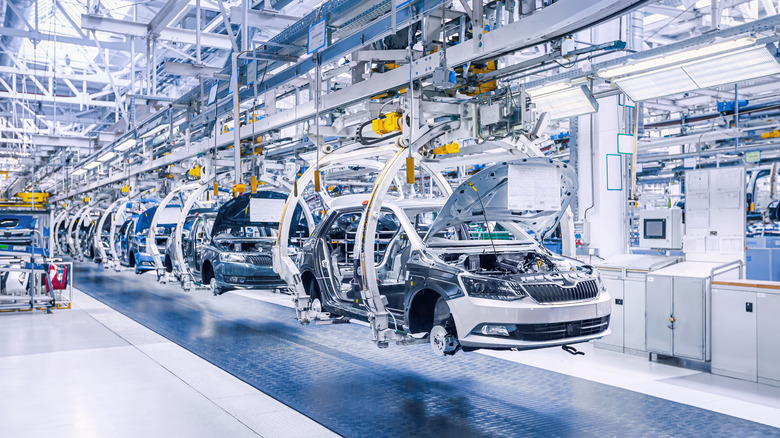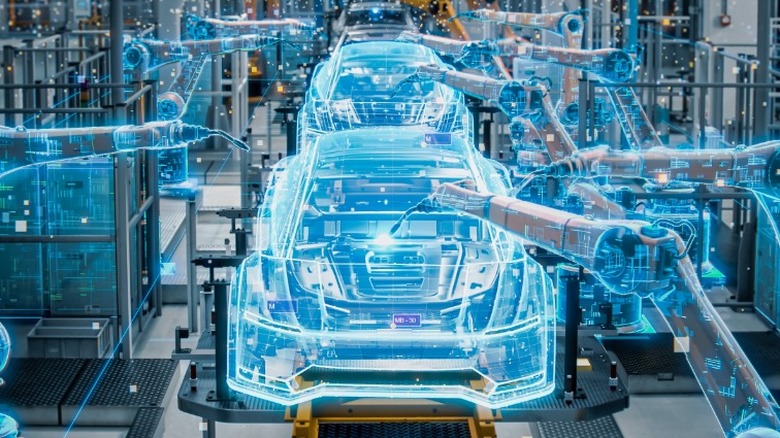The Satisfying Machines Involved In Building Cars
Auto assembly is among the most complex operations in existence, and it requires thousands of parts, people, and machines to make it all work. While early automobiles were built individually by hand, the implementation of the assembly line led the way for mass production, and the worldwide adoption of the automobile. With the demand for automobiles increasing every year, production methods have evolved into the complex and sophisticated manufacturing plants we have today.
Producing machinery on a mass scale requires more machinery. Automotive manufacturing plants are dotted all over the world, employing millions of workers, and they all rely on a mind-boggling array of machines and equipment to deliver brand new cars to the dealer showrooms. Once crude and dirty manufacturing floors have given way to technologically advanced operations full of mesmerizing machines assembling parts with speed and precision. These assembly lines offer fascinating, and almost hypnotic, visuals of what some would consider the satisfying machines used to build automobiles.
Assembly Line History
Early automobiles were assembled piece by piece with most parts being machined individually, and custom fit to each car. Skilled craftsmen and machinists used their knowledge and talent to painstakingly assemble automobiles for delivery to wealthy patrons. Ransome Eli Olds first produced automobiles on an assembly line with his Curved Dash Oldsmobile in 1901 (via ThoughtCo). However, it was Henry Ford who turned things up to 11 when he envisioned, and then created, the moving assembly line, an automated manufacturing floor with workers installing parts to a car one by one.
The primary contribution by Ford that made this possible was producing interchangeable parts, all manufactured to the same standards. This allowed workers to replicate the same motion over and over, installing the same parts onto dozens of vehicles as they moved down the line, with the parts fitting every time. The first machines utilized in the assembly were the motors and conveyor belts that moved the vehicles along the line. This new concept opened the door for Ford to not only produce millions of cars but to also drop the price to $260 while paying workers the unheard-of sum of $5 per day (via ThoughtCo). Many of the factories from the early days of Detroit auto manufacturing continue to operate today, such as the Mack, home of the Jeep Grand Cherokee.
The Human Element
Manufacturing machines and assembly lines are nothing without people to operate them. While the level of technology and sophistication has increased exponentially, there does not likely exist a time soon when manufacturing can be completed without human hands. However, machines have taken over many positions that once required human involvement. They have taken personnel away from some of the most dangerous jobs, and reduced the opportunities for repetitive motion injuries (via Universal Robots).
Auto workers are increasingly needed to operate sophisticated equipment with advanced knowledge of programming, automation, and robotics. While assembly workers are still plentiful on the factory floor, highly educated professionals are a larger part of the workforce in modern times. Chron says that much of the manual labor associated with auto manufacturing has been eliminated, but many of the labor-intensive positions have been replaced with quality control workers. The machines performing the repetitive labor tasks require humans for oversight to ensure everything operates properly. The machines are not taking over just yet.
Automation
The key to a well-functioning assembly line is automation. Manufacturing plants of the past developed mechanical assembly lines to keep things moving at a consistent, but manageable pace. Parts would still be attached by hand, but the cars themselves would move from one station to another automatically. According to the Association of Advancing Automation, Japan in the 1930s developed the micro-switch and accurate electrical timers that brought about significant improvements to the automated assembly line. These inventions would be adopted around the world, increasing manufacturing output significantly. The rebuilding of Japan after World War II gave their companies opportunities to integrate new technologies into the manufacturing process, and contributed greatly to the establishment of the high standards of quality Japan is known for today.
Computer programming presented opportunities to automate more of the process, with machines performing even more complex tasks. Rather than gears and switches automating the line, computer controls made machines capable of performing several steps previously only capable by workers. Perhaps the biggest contribution to the full automation of the assembly line was the invention of the Unimate, the first manufacturing robot patented in 1961 (The Atlantic). This development started the trend toward the near complete automation of auto manufacturing we have today.
Robotics
Adding robotics to the assembly line adds a significant level of sophistication to the automation of auto manufacturing. With robots being integrated into manufacturing in the early '60s, certain functions of assembly could be carried out reliably and safely 24 hours a day, often replacing the job of multiple workers. In the early '80s, Ford began installing robots to spot-weld together body panels to create completed bodies. The Ford Fiesta was one of the first cars to ever have robots inject anti-corrosion sealants into the frame (via CNN). While the early robots were programmed to repeat functions according to set parameters, modern robots use laser guides to make adjustments based on real-time inputs, further enhancing their utility.
The impact of robotics on auto assembly is immeasurable. They have eliminated many jobs on the factory floor, but brought with them new ones, often positions requiring highly skilled and educated individuals (via Flex). They have also made precision manufacturing on a mass scale possible. According to It Still Runs, robots can do such things as laser welding with pinpoint precision and effectively zero errors. This has raised the general build quality of all automobiles to a standard unheard of in previous decades. Furthermore, robots have made auto manufacturing safer, with Hyundai recently testing Boston Dynamic's autonomous robots on the floor to identify dangerous situations before they occur. The full-scale integration of automation and advanced robotics is almost certainly the reason that decades ago, cars would be worn out by the time they hit 100,000 miles, while modern ones regularly run perfectly well with double that (via Progressive).
Types of Machines
To list all the machines employed in an auto plant would be an exercise in futility. But here are some of what you might find on a typical plant floor (via Robotics Business Review).
Assembly machines install parts and tighten fasteners. Some of the newest machines include tire installers that can accurately position tires on the car, and tighten all the lug nuts simultaneously
Spot and arc welders assemble complete bodies of modern cars. They often have dozens of arms that spot weld multiple points of the body at once. These machines appear as if they are a team of robots descending on loose body panels that emerge from the machine as a complete car.
Painting, coating, and sealing robots take humans away from some of the most hazardous environments full of noxious chemicals and gases. They also leave cars with perfectly smooth finishes gleaming as they leave the factory floor.
Part transfer and machine tending robots pick up finished parts off of presses and CNC machines to transfer to another part of the assembly process. These are particularly useful in areas of the foundry, where molten metals reach thousands of degrees and pose significant hazards to humans.
Material removal robots help to turn raw panels and trim into finished parts. For items, for example, that come out of a press and need clean edges, precision laser-guided robots can cut straight, clean edges, preparing a part for final assembly.
Logistics robots are used to move parts and raw materials in place for installation. These mechanized, robotic systems can track inventory, and ensure stations around the factory are properly stocked and well supplied for smooth, continuous operation.
When all these systems operate at full capacity and without error, auto plants can run continuously for weeks on end with ever-increasing efficiency. They not only make it possible to build more cars in less time, but they also do it while keeping the threat of injury to workers lower than ever.
Power and Hand Tools
While the large moving lines, and complex robots, dominate the factories of auto manufacturers, common hand and power tools still play a significant role in assembly. There are still many areas of the car that require the dexterity of the human hand in final assembly, namely in tight spaces where a robot is impractical. Workers for these positions require a variety of tools to complete their tasks. Engine assembly is still labor-intensive, and requires people with a variety of tools to assemble them.
While the tools used on the factory floor look pretty much the same as what you may have in your toolbox at home, there can be significant differences. Bosch offers a line of production tools that are made to withstand the rigors of being used for repetitive tasks for hours on end. This includes drills, power screwdrivers, impact wrenches, and more. Cleco also offers specialized tools for manufacturing. Unlike a typical mechanics tool that is used for a variety of repairs, these tools are often built for a single purpose, such as installing the same size nut over and over all day long, without any change in size throughout the day. They can also be set to a specific torque so that the same nut will be tightened to exact specifications on every car that passes through the line. You are not likely to find these at any store as they are highly specialized for manufacturing only.
Assembly Lines
Assembly lines are, to some, most fascinating. The sights and sounds of the assembly line can be a soothing and satisfying sort of ASMR, or just an engaging look into how things are made.
Auto companies in the '30s liked to show off their "engines of industry," and the strength and power of the automotive industry. This 1936 film by Chevrolet has certainly chosen a peculiar and dramatic soundtrack:
Fast-forward a few decades, and the advances in technology become obvious in this 1962 film of a Dearborn, MI Ford plant:
By the '80s, auto assembly lines were largely robotized, with a significant portion of work being done by machines. However, in communist East Germany, things were a bit archaic and outdated in this Trabant factory in 1988:
In contrast to the factories of the past, a modern BMW factory shows what efficient and orderly manufacturing looks like in this bright, clean, and modern assembly line:
Future of Auto Manufacturing
While some things will inevitably remain on the factory floor, expect to see even more technology than we have now. Humans will always have a role in the process, but machines may still take a larger role. Some of the advances may consist of working with machines that have more dexterity, and more compact components. Wired recently wrote about the machines used in Ford's assembly lines that are increasingly using AI and 3D printing to speed things up. When robots can be set up to use machine learning to improve processes, efficiency increases. The further integration of machine learning will make robots more adaptable and flexible, and productivity should continue to rise. 3D printing will also continue to make manufacturing more flexible, especially in the ability to produce low-volume parts affordably.
Nobody knows what is coming next, but the future of the automotive industry is in flux with transitions to electric cars, and further attempts to clean up emissions. One thing does appear to be certain, though: People will be driving cars for decades to come, and these car-building machines will be with us for the long haul.
